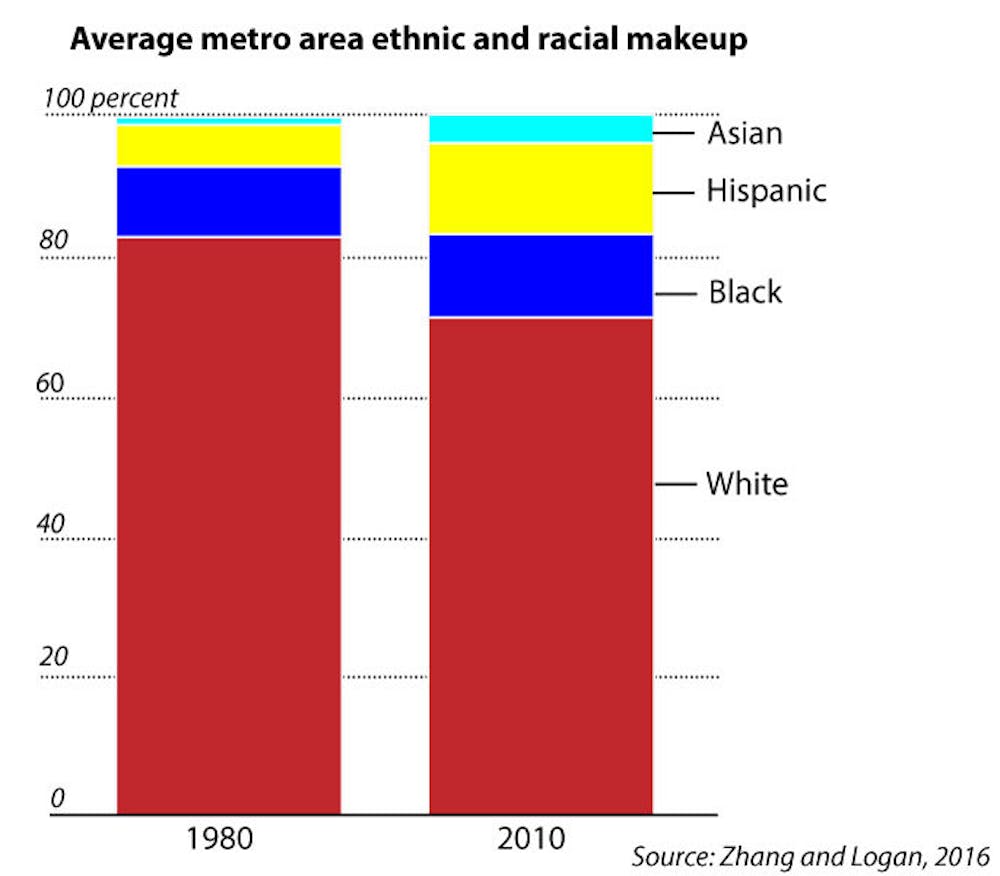New research conducted by Professor of Sociology John Logan demonstrates that cities across the United States are becoming more integrated. The study, published in the journal Demography as “Global Neighborhoods: Beyond the Multiethnic Metropolis,” tracked populations in 342 metropolitan regions over the past three decades.
In the paper, Logan and co-author Wenquan Zhang, assistant professor of sociology at the University of Wisconsin at Whitewater, coined the term “global neighborhood” to describe a region with substantial white, black, Asian and Hispanic presences. They found that in the past three decades, the number of these global neighborhoods has steadily increased, not only in metropolitan areas but also in urban regions throughout the country. “This is a new phenomenon, because … in 1980 there were a lot of all-white neighborhoods,” Logan said.
Logan pinpoints Asian and Hispanic presence as a key factor in opening up neighborhoods to ethnic diversity and in weakening traditional race boundaries. “We don’t see African-Americans entering into these previously all-white neighborhoods until at least Asians or Hispanics are there first,” he said.
Historically, whenever African-American populations entered a neighborhood, its white residents would leave. Logan said that this phenomenon became so common that urban scholars created specific terms to describe each phase of change: An initially all-white neighborhood experiences a perceived “invasion” when blacks move in, followed by a period called “succession” during which the neighborhood population becomes predominantly black.
Logan argues that the rise in Asian and Hispanic presence in a given neighborhood disrupts America’s traditional black-and-white race boundaries and leads whites to be more open to black residents in their communities.
But the study notes a simultaneous trend that indicates an increase in the number of all-minority neighborhoods, implying that whites are moving out of neighborhoods with substantial numbers of people of color. “The glass is filling and emptying at the same time,” Logan said.
Stefano Bloch, postdoctoral senior research associate in urban studies, found these trends of both increasing and decreasing diversity to be of particular interest.
Bloch said that in 1990, Los Angeles was 33 percent white, while it is now roughly 23 percent white. But one Echo Park district grew from 11 percent to 56 percent white in that same time period. “So while the city has become more diverse, particular neighborhoods have become overwhelmingly white,” Bloch said.
Bloch pointed to ethnic enclaves as other outliers. The greatest representation of Vietnamese people outside of Vietnam is in Orange County, California, he said, and the United States is also home to the largest Somalian and Hmong populations outside of their countries of origin. “The communities that buck the trend of diversity are not just white but also underrepresented groups,” Bloch said.
The combination of “congregation, segregation and gentrification” drives these transformations, Bloch said.
The complex outcomes of this study leave room for further inquiry, said Professor of Sociology Michael White. A future study could examine the same issues upon the release of the next census. “What has happened since then — whether the trend continues or not — will be of significant interest,” he said.
The study’s most significant effect is likely its impact on people’s awareness of the trends it identifies, Logan said.
“Most Americans think that the ghetto … is something of the ’50s and ’60s,” Logan said. “If you’re aware of it, you could potentially see it as a problem.”





